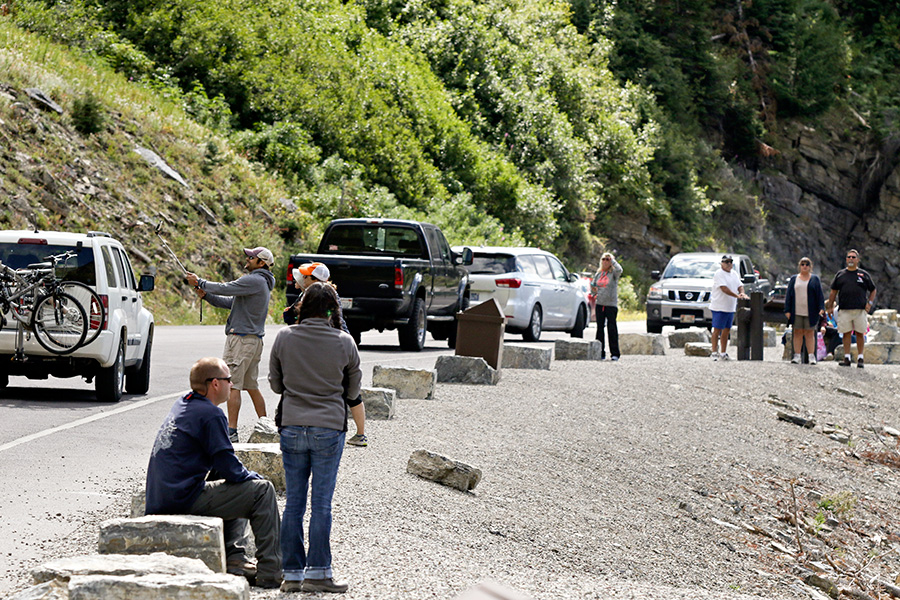Memorial Day weekend marks the official start to the summer tourist season in the Flathead Valley, a time when warm days and cool evenings play host to visitors and residents looking to stretch their legs after a long winter.
For many, it means venturing into Glacier National Park — perhaps for the first time this year or the first time ever — a summertime bucket-list item that people of all stripes often share. Suddenly, Going-to-the-Sun Road is packed with vehicles, and the trails fill up with explorers.
The love shown for the park only seems to be growing with visitor counts, which complicates the logistics of having so many people on the ground and on roads within the park’s borders.
Last year, the park set a visitation record, its third in three years, with 2.9 million people, a full 24 percent increase over 2015’s visitation. It was an increase of nearly 600,000 people, according to the National Park Service, causing parking issues and traffic obstructions unlike anything the park has experienced before.
The NPS has spent several years studying traffic and congestion as part of a proposed corridor management project on Going-to-the-Sun Road. The NPS is expected to release the report this summer.
As much as the mountains and lakes are part of the Glacier experience, so is traffic congestion. Lauren Alley, spokesperson for the park’s administration, said there are several plans in place to help mitigate some of the traffic hiccups this summer.
First, Glacier Park and Flathead County’s Eagle Transit have teamed up to make the new summer bus shuttles to the park, not just within the park, run from July 1 to Sept. 4. It will cost $5 per round trip.
Dale Novak, transportation manager at Eagle Transit, said the program should keep thousands of cars out of the park by transporting people on buses from Kalispell, Columbia Falls, Hungry Horse, and Coram for half and full days in the park.
“It’s actually something that I’ve been pushing for for about three years, but we just were finally able to make it work this year,” Novak said. “It’s an exciting thing, and the park is working with us on it. They’re providing the fuel and the driver, and we’re providing the bus and the maintenance on the bus.”
Eagle Transit already works within the park’s borders, operating a free shuttle running up and down Going-to-the-Sun Road. Now, instead of having people park at Apgar or in West Glacier for the shuttle, Novak said they can leave their cars back in the valley.
Ridership on the shuttles last year was 209,000 in the park, Novak said. With estimates that each car carries an average of 2.7 people, and then dividing that in half again for people making more than one trip, Novak estimated the service eliminated about 38,000 cars in the park.
“It’s a lot of cars,” Novak said. “Especially when you divide it up — we have a 66-day season this year.”
The shuttle will travel from Rosauers in Kalispell to Flathead Valley Community College, Super One in Columbia Falls, the nearby park and ride, and then the respective Cenex stations in Hungry Horse and Coram. It will make a final stop at the Discovery Center in West Glacier before landing at the same plaza where the park’s free shuttle service starts.
It may be a small change, but Novak believes enough small changes could start making a dent in the traffic-congestion issue.
“I understand too that even with this new bus to the park during the season, it’s not going to make all the difference, but I feel like it’s going to add to it,” he said. “And if we keep coming up with more and more pieces, I think it will help with that congestion.”
Novak said there would also be two new, large buses added to the park’s east side fleet, with four more expected next summer.
Alley, the park spokesperson, said the park also intends to use data collected from previous summers to help steer visitors away from congested areas, as well as implement limits for critically congested areas, the same way the Logan Pass parking lot can only accommodate a certain amount of vehicles, so if one car leaves, another can take its place.
There will also be visitor service assistants at Avalanche similar to those at Logan Pass, who will be able to help people park and navigate the traffic.
For more information on Glacier Park’s traffic and road conditions, visit www.nps.gov/applications/glac/roadstatus/roadstatus.cfm. For the summer bus schedule to Glacier Park, visit www.flathead.mt.gov/eagle or call (406) 758-5728.
